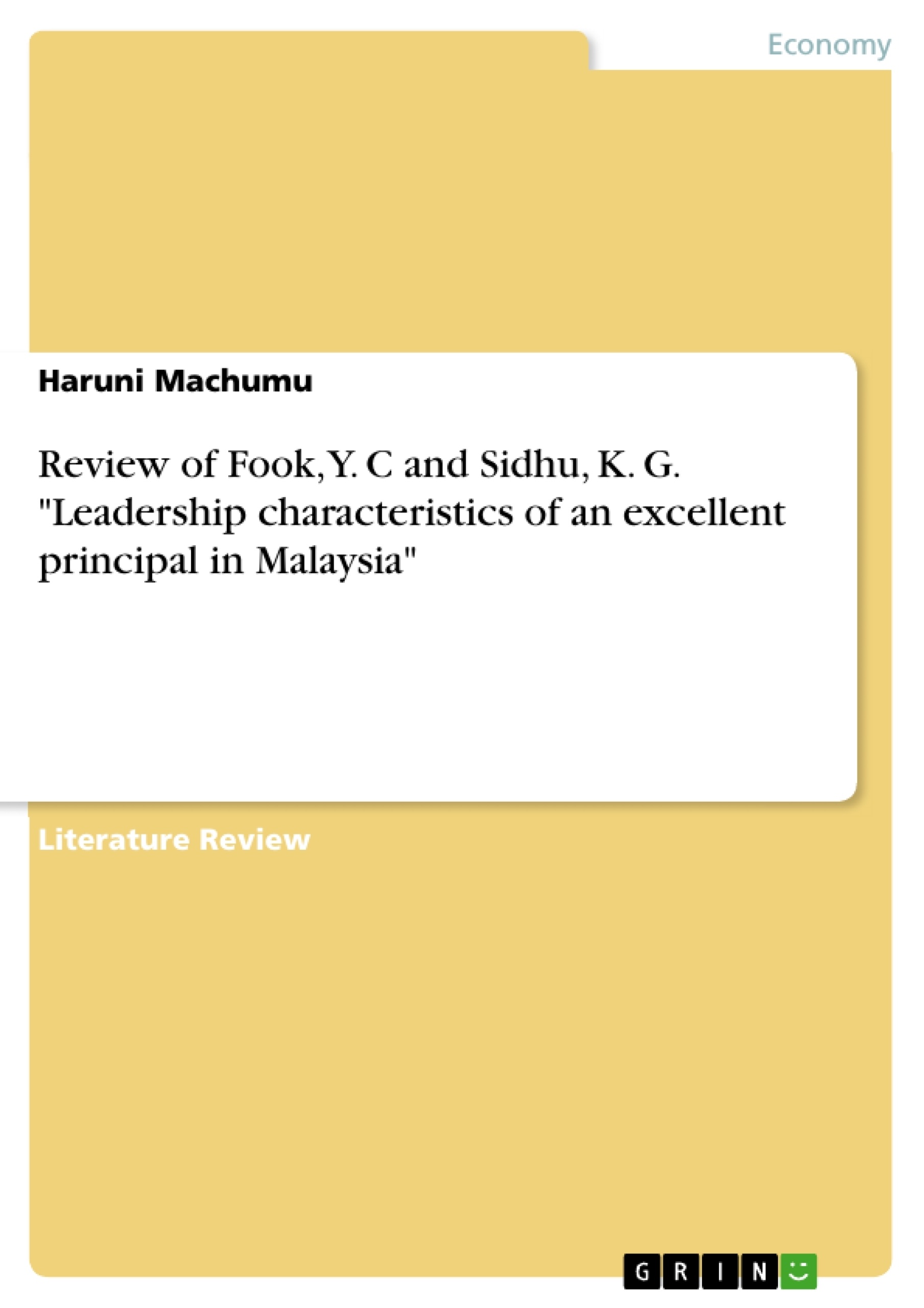This paper presents analysis of a successful leader as discussed in the paper. Leadership characteristics and styles are discussed in line with the reviewed paper. The role played by Malaysia government to reward and motivate school managers, principal to do well in their endeavour are paramount to other part of the world specifically less developed countries. The paper reads well.
Preliminaries
The article “Leadership characteristics of an excellent principal in Malaysia” is about an excellent principal in Malaysia. The specific purpose of the article is to explore the leadership characteristics of an excellent school principal. It is a succinct, elegant and well researched work of two authors: Chan Yuen Fook and Gurnam Kaur Sidhu both from faculty of education, MARA University of Technology in Malaysia.
Summary of the article content
The article is divided into six major parts, which are abstract, introduction, background of the study, research design, findings, implications and recommendations as well as conclusion. In introduction parts the article provides a clear picture of leadership characteristics, types, styles (transactional, instructional, invitational and transformational) and functions in Malaysia. The situation of education (growing demand), preparation of school leader and legal aspects in Malaysia is also discussed in this part. The second part (background of the study) discusses vision and mission of Malaysia in terms of educational excellence, critical demands for greater equity and accountability issues. Also the school heads roles “sense makers” and agents of change” and roles of Ministry responsible is narrated clearly. The third part (research design) attempt to address research design issues whereby qualitative case study method was employed to collect and analyze data. One successful school having leadership characteristics of an excellent principal was selected as a sample, since varied number of awards a school posses and principal outstanding effort to create conducive teaching and learning environment. However the study employed multiple methods and data collected through extensive interviews, casual conversations, observations and reviews of school policy, annual school magazine and reports.
The fourth part (findings) attempts to explore the leadership characteristics and how far the school head share her school vision and mission with teachers and students as well as community at large. This part categorized into six themes reflecting on the objectives of the study and research questions (what is the mission and vision of the school?, what are the principal’s leadership strategies?, what are the leadership styles practiced by the school principal?, what are the excellent personal attributes demonstrated by the principal?, what are administrative roles played by the principal? and what are the limitations of the principal?). It address principal so called Aminah (pseudo names) background; vision and mission and leadership strategies; leadership styles (instructional, situational, distributing, invitational, people-centered); personal attributes (moral and values, religious, collaborative, humble, hard worker, and principle-oriented and communication and motivational skills); administrative roles (administrator and manager, instructional leader, motivator); Aminah’s limitations (too result oriented, little time to interact with subordinates, too ambitious, ever-increasing demands).
The fifth part is implications and recommendations whereby suggested practical examples and criteria to be adopted for successful leader are narrated. The study implies that school should be managed through identifying and proposing criteria to be recognized and experiences such as shaping the future, lead learning and teaching, developing self-awareness and working with others, managing organization and securing accountability as well as strengthening community relationships. The article concludes with analysis of the intensity and complexity of the leadership role in the school, leadership styles, and approaches matching with particular stages of school development.
Reactions to the article
Successful school heads or principal wherever, should identify importance competencies criteria such as defining vision and mission, enhancing teaching and learning, creative, innovative, critical thinking, problem solving and effective communication and motivational skills. Strategic planning and management of competing forces must be a pivotal of leadership training for school improvement as high achieving learning communities. Thus, this spirit should be enhanced as a process to achieve positive performance.
The Strength of the article
Content Strengths
The article is well-organized and makes an extensive use of critical example, sufficient documentation, notes, and up to date bibliography information on leadership. The approach enables the reader to have a better insight and understanding of the content. Discussions is based on principal’s background, her vision, mission and leadership strategies and leadership styles, personal attributes, administrative roles and limitations.
[...]
- Arbeit zitieren
- Tutor Haruni Machumu (Autor:in), 2011, Review of Fook, Y. C and Sidhu, K. G. "Leadership characteristics of an excellent principal in Malaysia", München, GRIN Verlag, https://www.grin.com/document/179728
-

-

-

-
Laden Sie Ihre eigenen Arbeiten hoch! Geld verdienen und iPhone X gewinnen. -

-
Laden Sie Ihre eigenen Arbeiten hoch! Geld verdienen und iPhone X gewinnen. -

-
Laden Sie Ihre eigenen Arbeiten hoch! Geld verdienen und iPhone X gewinnen. -

-
Laden Sie Ihre eigenen Arbeiten hoch! Geld verdienen und iPhone X gewinnen. -

-
Laden Sie Ihre eigenen Arbeiten hoch! Geld verdienen und iPhone X gewinnen.

